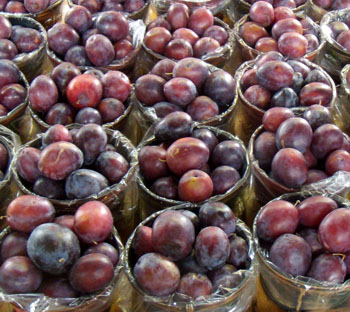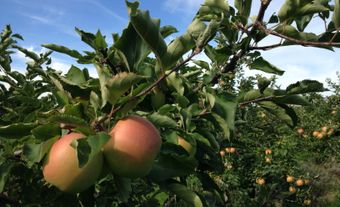
Fruit growing is an important part of Canada’s food industry. Growing is usually restricted to areas where winter temperatures do not go much below -20°C. For this reason, the majority of commercial fruit growing in Canada occurs in British Columbia, Ontario and Québec, while the remainder is mostly concentrated in Nova Scotia and New Brunswick.
Species
Most of the fruit species cultivated in Canada belong to the rose family. They include fruits such as apples, pears, peaches, nectarines, plums, prunes, cherries and apricots, as well as berries such as strawberries, raspberries, cranberries and blueberries. Other important families are Saxifragaceae (currants and gooseberries) and Vitaceae (grapes).
Each fruit species has many cultivars (commercial varieties), developed for various characteristics. For example, in Canada adaptation to specific climatic factors (e.g., cold winters) is important. Breeding and selection programs give priority to these requirements, while crop research programs have developed many cultivars.
Industry
The fruit and vegetable industry is an important part of the agriculture and food distribution sectors of the economy.
Canadian-grown fruit is marketed fresh or is processed in various ways. For example, while most apples and "tender" fruits (cherries, peaches, pears, plums, prunes) are sold fresh, a good proportion is processed into juice, sauce, pie filling, frozen slices and other products.
Sweet cherries are processed for brining (for maraschino cherries) or are frozen (for ice cream and baking use). Tart cherries are frozen or canned (for pie filling, jams, jellies and juices). Most Canadian-grown grapes are processed into wine and juice. Perishable fruits (e.g., strawberries, raspberries and blueberries) are preserved by freezing or canning.
Some fruits, particularly apples and pears, are stored at harvest rather than being processed or immediately sold fresh. The fruit continues to live after harvest, using oxygen, giving off carbon dioxide and generating heat (i.e., by respiration). This process eventually leads to breakdown of fruit tissues. Refrigeration and controlled-atmosphere storage allow fresh fruit to be marketed almost year-round.
British Columbia

Strawberries, raspberries, loganberries and grapes are cultivated in the Lower Mainland area, but the fruit-growing region is the Okanagan Valley. The valley is in the rain-shadow area of the interior; hence, fruit growing is dependent on irrigation. The complete range of fruit crops is grown, but the major crop is apples. Most orchards are located on the top and sides of terraces along the sides of lakes. Deep, dividing gullies, running from the high slopes down to the water, provide necessary air drainage to prevent frost damage. Winter damage to trees is a recurring problem.
Ontario

The moderating influence of Lakes Huron, Erie and Ontario, coupled with suitable soils, allows the growing of a complete range of fruit crops in southwestern Ontario. The more tender fruits (e.g., peach, cherry, grape, plum, pear) are limited to the Niagara Fruit Belt on the southwest shore of Lake Ontario. Apples are grown over much of the southern part of the province, including the south shore of Georgian Bay.
Québec
Orchards are located mainly on light soils around the bases of old volcanic hills that rise above the dry loams of the plains, and in the foothills of the Appalachian Mountains, near the US border. Low winter temperatures can cause extensive tree damage.
Nova Scotia
Production is confined to the Annapolis Lowlands, where soil type and climate are well suited to the production of apples, blueberries and strawberries. Winter temperatures often dip to -24°C; hence, peach and cherry growing is marginal.
New Brunswick
Severe winter temperatures restrict production to the Saint John River valley. Only apples can withstand severe winter temperatures (often -24°C, but reaching -34°C). Some blueberries and strawberries are also grown.

 Share on Facebook
Share on Facebook Share on X
Share on X Share by Email
Share by Email Share on Google Classroom
Share on Google Classroom





